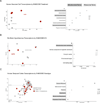Mitochondrial DNA variation in Alzheimer's disease reveals a unique microprotein called SHMOOSE
- PMID: 36127429
- PMCID: PMC10027624
- DOI: 10.1038/s41380-022-01769-3
Mitochondrial DNA variation in Alzheimer's disease reveals a unique microprotein called SHMOOSE
Erratum in
-
Correction: Mitochondrial DNA variation in Alzheimer's disease reveals a unique microprotein called SHMOOSE.Mol Psychiatry. 2023 Apr;28(4):1827. doi: 10.1038/s41380-023-01956-w. Mol Psychiatry. 2023. PMID: 36658336 No abstract available.
Abstract
Mitochondrial DNA variants have previously associated with disease, but the underlying mechanisms have been largely elusive. Here, we report that mitochondrial SNP rs2853499 associated with Alzheimer's disease (AD), neuroimaging, and transcriptomics. We mapped rs2853499 to a novel mitochondrial small open reading frame called SHMOOSE with microprotein encoding potential. Indeed, we detected two unique SHMOOSE-derived peptide fragments in mitochondria by using mass spectrometry-the first unique mass spectrometry-based detection of a mitochondrial-encoded microprotein to date. Furthermore, cerebrospinal fluid (CSF) SHMOOSE levels in humans correlated with age, CSF tau, and brain white matter volume. We followed up on these genetic and biochemical findings by carrying out a series of functional experiments. SHMOOSE acted on the brain following intracerebroventricular administration, differentiated mitochondrial gene expression in multiple models, localized to mitochondria, bound the inner mitochondrial membrane protein mitofilin, and boosted mitochondrial oxygen consumption. Altogether, SHMOOSE has vast implications for the fields of neurobiology, Alzheimer's disease, and microproteins.
© 2022. The Author(s), under exclusive licence to Springer Nature Limited.
Conflict of interest statement
Competing Interests
Intellectual property related to SHMOOSE has been filed by the University of Southern California.
Figures








References
Publication types
MeSH terms
Substances
Grants and funding
- T32 AG000037/AG/NIA NIH HHS/United States
- U01 AG061356/AG/NIA NIH HHS/United States
- R01 AG068405/AG/NIA NIH HHS/United States
- R56 AG062693/AG/NIA NIH HHS/United States
- P01 AG055369/AG/NIA NIH HHS/United States
- RF1 AG061834/AG/NIA NIH HHS/United States
- R01 AG015819/AG/NIA NIH HHS/United States
- P30 AG072975/AG/NIA NIH HHS/United States
- R01 DK118402/DK/NIDDK NIH HHS/United States
- R01 AG017917/AG/NIA NIH HHS/United States
- U01 AG024904/AG/NIA NIH HHS/United States
- R01 AG069698/AG/NIA NIH HHS/United States
- P30 AG010161/AG/NIA NIH HHS/United States
- P30 AG066530/AG/NIA NIH HHS/United States
- P30 AG068345/AG/NIA NIH HHS/United States
- F31 AG059356/AG/NIA NIH HHS/United States
LinkOut - more resources
Full Text Sources
Other Literature Sources
Medical
Molecular Biology Databases

